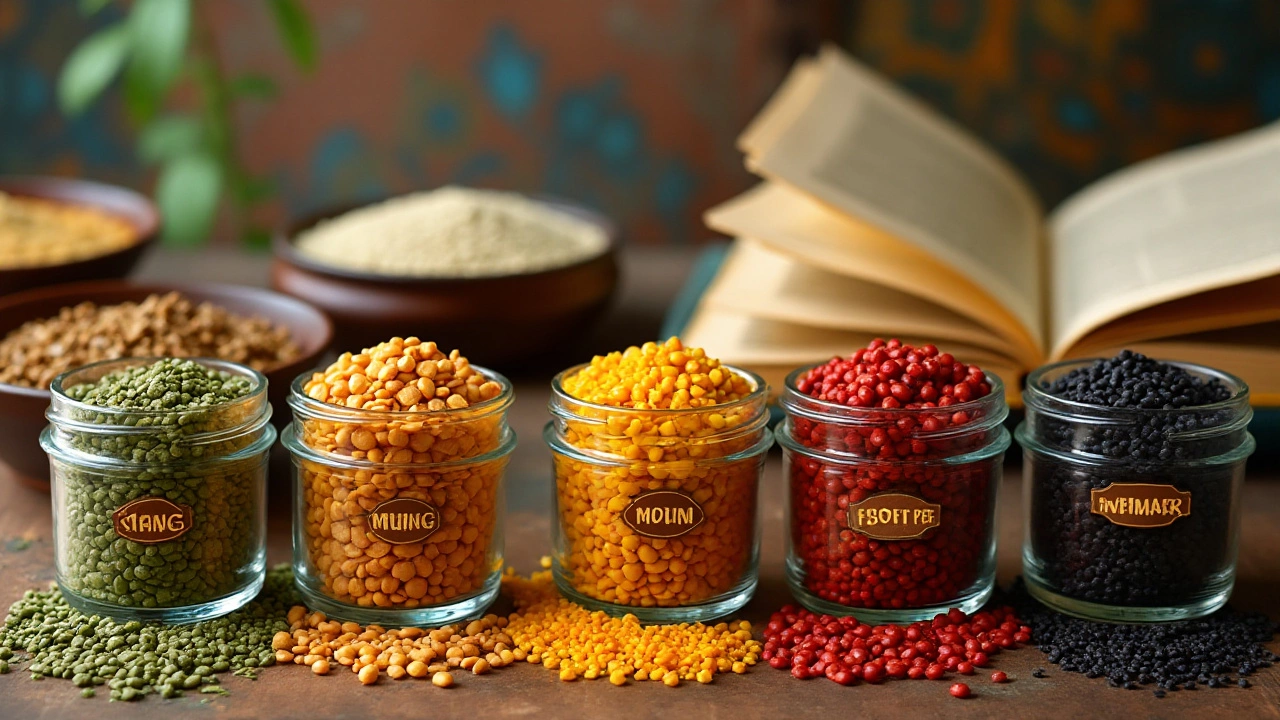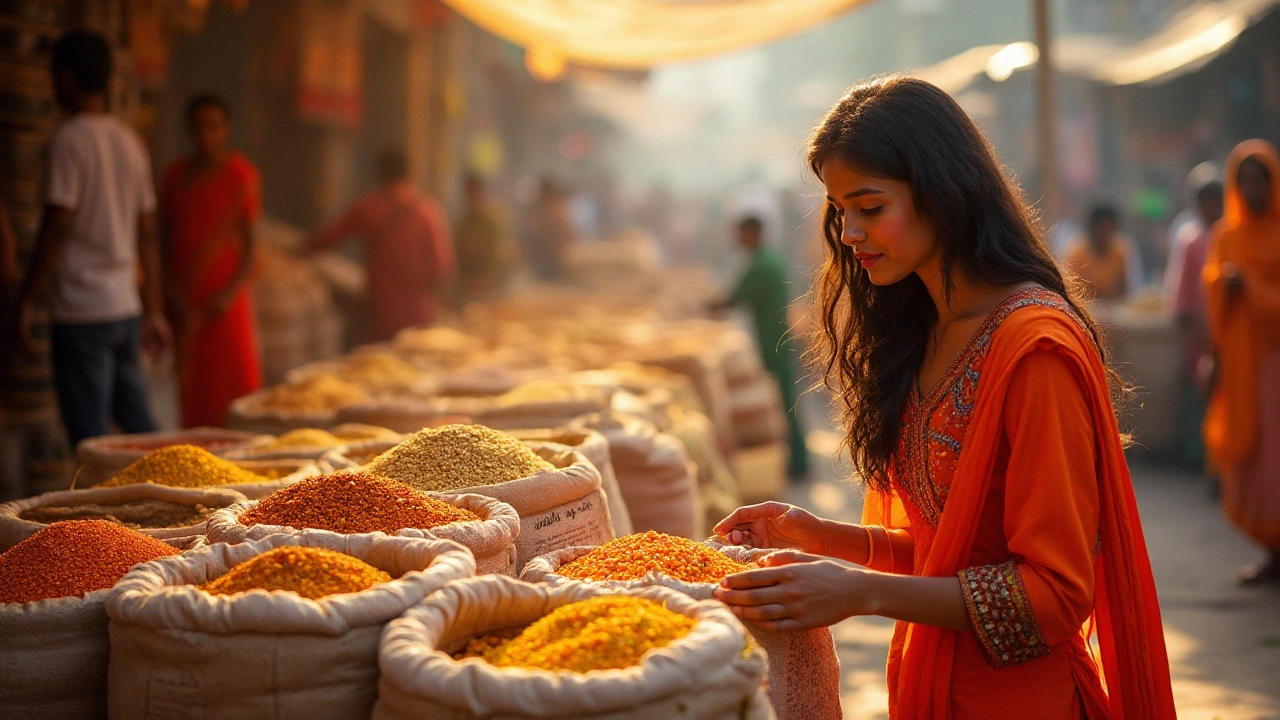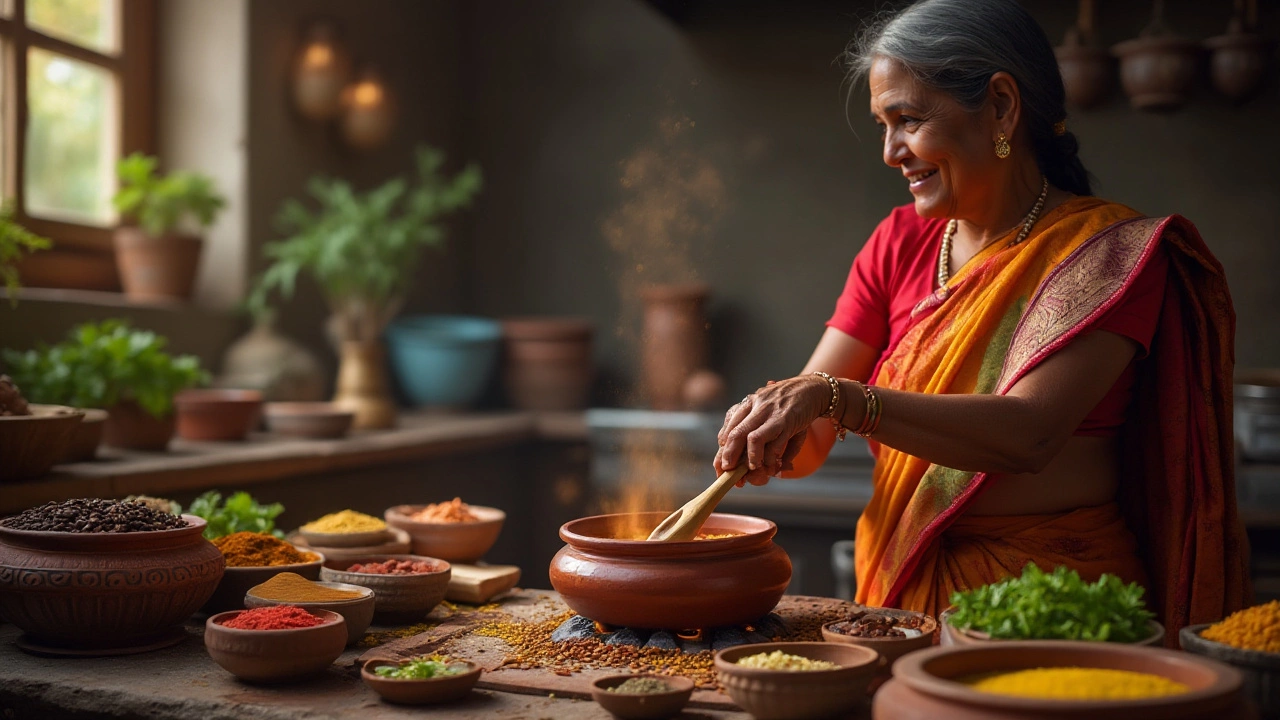4 Jan 2025
- 0 Comments
In the vibrant world of culinary arts, 'dal' is a staple that often baffles many due to its widespread usage, especially in Indian kitchens. But just as common as it is in households where it serves as a comfort food, the question 'What is dal called in English?' often arises.
The term 'dal' primarily refers to lentils in English, but it encompasses a variety of split pulses. These tiny but mighty legumes are cherished not just for their palate-pleasing nature but also for their nutritional value.
Let’s journey through the enticing and simple recipes that highlight dal’s versatility, offering flavors and techniques that can be seamlessly integrated into everyday cooking. Alongside, we’ll share handy tips to ensure your experience with dal is as flavorful as it is fulfilling.
- What is Dal?
- Is Dal the Same as Lentils?
- Varieties of Dal
- Simple Dal Recipes
- Cooking Tips and Tricks
- Nutritional Benefits of Dal
What is Dal?
At the core of Indian culinary tradition lies dal, a term that both intrigues and delights those unfamiliar with it. Dal refers not just to one single item but to a collective group of legumes, including lentils, peas, and beans, which are hulled and split. The distinction between dal and other pulses lies primarily in this unique preparation process. While lentils in English mention encompasses whole seeds, dal indicates these very same seeds but processed to enhance their cooking potential. Cultural richness wraps around each grain, carrying with it stories and diverse practices of food preparation that have been passed down generations.
To many, dal serves as more than just sustenance; it's a versatile ingredient that adapts to numerous dishes, each region adding its twist and flavor. In India, the sheer variety of dals can be overwhelming. There are masoor dal (red lentils), toor dal (pigeon peas), chana dal (split chickpeas), and moong dal (mung beans), to name just a few. This diversity is a testament to local tastes and the adaptability of another staple grain—lentils. Often, dal forms a hearty accompaniment to rice or bread, providing a protein-rich complement to largely vegetarian diets. To increase our understanding, here is a quote from Indian chef, Sanjeev Kapoor,
'Dal is much more than just food. It embodies the warmth of home, the comfort of tradition, and a beautiful symphony of spices and aromas.'
Each type of dal has its distinct flavor profile, nutritional benefits, and cooking requirements. For instance, masoor dal cooks quickly with a slightly sweet taste, while chana dal offers a nutty punch and requires a bit more time to soften. These characteristics allow for creativity in cooking, from simple stews to elaborate soups, each dish maintaining its unique identity. Surprisingly, such small legumes pack quite a punch when it comes to nutritional content. Being low in calories yet rich in fiber and essential amino acids, dals serve as an excellent dietary choice not just in Indian households but across the globe. Consider this: USDA data suggests nearly one cup of cooked lentils provides around 18 grams of protein and 15 grams of fiber, making it a powerhouse of nutrition.
In recent years, there's been a growing interest worldwide in exploring dal recipes, offering a lens into the culture they come from. As people become more conscious of their dietary choices, the demand for plant-based protein sources like dal is on the rise. This trend underscores a broader shift towards healthier eating patterns, emphasizing the importance of lentils in maintaining a balanced diet. As you explore the robust universe of dals, understanding both their culinary potential and nutritious benefits will no doubt make them a cherished part of your pantry.
Is Dal the Same as Lentils?
When diving into the expansive culinary domain of Indian cuisine, one can't help but encounter the term dal. It's an essential component in Indian households, often served alongside rice or flatbreads. The term 'dal' raises a common question among those unfamiliar with Indian cookery, specifically: Is dal synonymous with lentils? To unravel this, let's start by clarifying that dal isn’t just a single type of pulse. Instead, it is both a name for a dish and a term that refers to a range of pulses, including lentils.
In English, 'dal' is referred to as split pulses, which can include lentils, peas, and beans—all commonly split and hulled. What this means is that while lentils are a prominent type of dal, they represent just one facet of the variety available. Among these, red and yellow lentils are particularly well-known. They cook faster and absorb flavors more readily, making them a favorite in quick and flavorful dal recipes. However, there exists a wide spectrum including black urad dal, mung dal, and the earthy toor dal, each lending its unique flavor and texture to dishes.
The Diversity of Dal
Dals are ubiquitous across all regions of India, each boasting its own style of preparation and variety of spices, which highlights dal’s versatility beyond lentil dishes. For example, while in the South, you might encounter sambhar, a spicy lentil stew brimming with vegetables, in Bengal, you might find a lighter, temperate preparation known as moong dal. In Gujarati cuisine, the sweet and spicy dal brings forward a balance of flavors, making each meal a unique experience. Understanding this diversity is key to appreciating the numerous ways dal can be incorporated into cooking.
"While lentils form a significant part of dal, not all dals are lentils," writes the eminent food historian, K.T. Achaya in his detailed exploration of Indian food culture.
Adding complexity to dal’s identity is its nutritional profile. Lentils, as one type of dal, are celebrated for their high protein and fiber content, which makes them a staple in vegetarian diets. A 100-gram serving of lentils generally contains around 9 grams of protein in addition to essential minerals and vitamins. It's this robust nutritional content that positions dal as an indispensable part of daily meals, nourishing both body and soul. Whether you're new to the world of dal or looking to deepen your understanding, recognizing its diversity and myriad uses is the first step in culinary exploration.

Varieties of Dal
Dal comes in a multitude of varieties, each with its unique flavor profile, texture, and culinary application. This lentil wonder, known as simply 'dal' in its native cuisine, is a cornerstone of not only Indian meals but is also a dietary staple found in many kitchens across South Asia. The diversity in dal varieties is vast and caters to different taste preferences and cooking styles.
One of the most popular is the Toor Dal, or split pigeon peas, often used in traditional dal recipes. Its slightly nutty flavor and thick texture make it an excellent choice for hearty stews and soups. Its distinctive taste can be a treat when combined with aromatic spices like turmeric and cumin. On the other hand, Moong Dal, or split yellow gram, is known for its light and delicate taste, making it a versatile choice whether you're cooking a humble khichdi or a zesty currying.
Each type of lentil has its own set of cooking properties and nutritional values. For instance, Chana Dal, or split chickpeas, is not only high in fiber but also plays a significant role in North Indian and Bengali cuisines. Used frequently in dishes such as dhokla and samoas, Chana Dal adds a slightly sweet flavor and firm texture to the mix. Masoor Dal, or red lentils, are perhaps the quickest to cook, often transforming into a creamy consistency that pairs beautifully with tomatoes and aromatic masalas.
Understanding the basic characteristics of these lentils is essential when deciding which to use in a recipe. Each has unique properties not just in taste but in terms of nutritional benefits, with varying levels of proteins and vitamins. Including a diverse array of these in your diet ensures a balanced nutrition. Interesting to note, historically dal was mentioned in ancient Sanskrit texts, illustrating its long-standing significance in the diet of the Indian subcontinent.
"Dal has been the comfort of our homes since time immemorial, painting our tables with the vivid hues of lentils and filling our bellies with warmth," notes culinary historian Parvathi Rajagopal.
Next time you wander through the grocery aisle, look beyond the labels of ‘red’, ‘green’, or ‘yellow’ lentils. Consider their region of origin and find the right combination of taste and nutrition that's right for you. Embrace the versatility of dal, experiment with mixing varieties, and perhaps even invent your own family classic dish. To sum up every meal can be a unique experience–a veritable symphony led by these humble pulses.
Simple Dal Recipes
Dal, or known sometimes as lentil dishes, are a quintessential element of many homes, particularly within Indian families. Its versatility makes it easy to adapt and enjoy, no matter your culinary expertise. To truly appreciate simple dal recipes, one must embrace its variations, as each type of dal brings an array of flavors and textures that can transform a meal. Preparing dal is a delicate balance between understanding its nature and enhancing it with spices and herbs, which define the distinct taste profiles. Whether it’s a quick weeknight meal solution or a comforting dish for a lazy Sunday brunch, dal serves as a wonderful addition that can stand alone or complement other foods.
Starting with the basics, one of the most loved versions is the humble Yellow Dal Tadka. Yellow moong dal lentils are flavorful and cook quickly, making them perfect for those moments when you need something comforting without much fuss. Begin by boiling the lentils until they are soft and creamy, and then temper with a tadka—a mix of spices like cumin, mustard seeds, and asafoetida sautéed in ghee or oil. A touch of garlic and ginger elevates the dish, creating a warming aroma as it cooks. This simplicity allows the dal to shine through, while also helping to introduce a burst of flavor when paired with rice or flatbreads.
Another beloved version is the fiery Masoor Dal. These red lentils lose their shape when cooked, resulting in a luscious mush that’s perfect with a spicy tempering. To make this dal, cook red lentils along with tomatoes, turmeric, and salt. For the tempering, sizzle mustard seeds, dried red chilies, and curry leaves in hot oil. The aroma as the spices hit the pan is intoxicating, and pouring this over the cooked lentils creates a tantalizing dish full of depth and heat.
"Cooking is all about people. Food is maybe the only universal thing that really has the power to bring everyone together." — Guy Fieri
There’s also the earthy charm of Chana Dal, which are split chickpeas. Unlike other lentils, these take a bit longer to cook, giving them a heartier texture that pairs beautifully with a blend of spices and chopped spinach for added nutrition. Chana dal has a nutty flavor, and when cooked with aromatic spices like cinnamon, cloves, and cardamom, it transforms into a robust dish that tantalizes the taste buds. Serve it alongside steamed rice and a dollop of ghee for added richness and you'll have folks coming back for seconds.
Simple dal recipes can be further customized by adding seasonal vegetables or greens, reflecting personal tastes and ingredient availability. For the health-conscious, adding protein-rich vegetables or tofu can turn a simple bowl of dal into a comprehensive meal. Here’s a quick guide to variations, serving ideas, and subtle adjustments one can make:
- Add finely chopped spinach or kale to your dal for a nutritional boost.
- Squeeze lemon juice or add a dash of raw mustard oil for enhanced flavor.
- Incorporate coconut milk into red lentil dal for a creamy, rich texture.
Dal is not just a recipe; it’s a canvas for creativity in the kitchen. From altering spices to trying new lentil varieties, each decision can transform the texture and taste in delightful ways. Making simple dal recipes opens you to a world where quick, nourishing meals are at your fingertips, perfect for any occasion or time of day.

Cooking Tips and Tricks
Mastering the art of cooking simple dal recipes not only requires a good understanding of the different varieties of dal but also an appreciation for the nuances in flavor that each type brings. One of the most essential tips is soaking the dal before cooking. By doing this, you're allowing the dal to absorb water, which shortens the cooking time dramatically. Generally, soaking them for about 30 minutes to an hour can make a significant difference in the texture of the final dish, resulting in a softer, creamier consistency that's much adored.
As you prepare your ingredients, keep in mind that toasting the dal gently in a pan before boiling can enhance its natural nutty flavor, adding a depth that water alone couldn't achieve. This is especially true for varieties like chana dal or toor dal, which have a more pronounced taste. After toasting, using fresh, filtered water helps maintain the dal's delicate flavor. It's interesting how just a small change in preparing your ingredients can elevate the dish from ordinary to exceptional.
Spicing plays a fundamental role in bringing out the best in dal. Depending on the type you're using, different assortments of spices can impart warmth, heat, or earthiness. Cumin seeds, mustard seeds, turmeric, and just a dash of asafetida go a long way in seasoning your Indian lentil dishes. Don't shy away from experimenting with your spice mix. A quote from the famous Indian chef Madhur Jaffrey encapsulates this perfectly:
"Spices are the common denominators of Indian cooking. They bring disparate elements together into one harmonious whole."
If you wish to add a garnish or tadka (tempering) to your dal, do so right before serving. This simple mixture of hot oil and spices can transform the final dish, elevating its flavors remarkably. For an explosion of texture and taste, try frying onions, garlic, and ginger with your spices before pouring the tempered oil over a steaming pot of dal. This practice not only creates layers of flavor but also contributes an enticing aroma that captivates the senses.
When it comes to consistency, personal preference dictates all. Some prefer their dal to be thicker, akin to a stew, while others enjoy a soup-like consistency. To adjust, add water gradually until your desired texture is achieved. A handy yet often overlooked tip is using a whisk to break down the lentils further, providing a more uniform, velvety consistency. Keep in mind that dal thickens substantially as it cools, so it's always better to keep it a bit more fluid if you plan on reserving it for later consumption.
Lastly, while it might be tempting to add salt early in the cooking process, hold off until the end. Adding salt too soon can harden the skin of the lentils, lengthening the cooking time and altering the texture unfavorably. It's a commonly known fact in culinary circles that patience with seasoning often results in a more cohesive, flavorful dish. By adhering to these simple yet impactful tips, preparing lentil dishes becomes not just an exercise in culinary basics but a flavorful exploration of taste and preference.
Nutritional Benefits of Dal
When we talk about the nutritional perks of dal, we're diving into a world where these humble legumes offer profound benefits that can transform not just dishes but also boost our health remarkably. From providing essential proteins, especially in vegetarian diets, to being a powerhouse of important minerals, dal holds an esteemed place in nutritional science. Lentils, the English equivalent for dal, contain low levels of fat yet are high in complex carbohydrates and fiber, offering sustained energy and aiding in proper digestion. Their high protein content, which almost rivals that of meat, makes them an indispensable element in vegetarian and vegan nutrition. A single serving of dal can cover a significant portion of your daily protein needs.
Dal doesn’t stop at proteins. They are enriched with essential micronutrients such as folate, iron, and potassium. Folate is vital for cellular function and tissue growth, while iron aids in preventing anemia by keeping the red blood cell count and hemoglobin in check. Potassium contributes to fluid balance and assists in maintaining normal blood pressure. Eating a variety of dals can ensure a well-rounded intake of these minerals. According to the USDA, a cup of cooked lentils contains about 230 calories but more importantly provides around 18 grams of protein and 15 grams of fiber.
Let's not forget that dal is packed with antioxidants, which play a crucial role in protecting the body against oxidative stress and inflammation. These antioxidants, including polyphenols, have been linked with a reduced risk of cancer. Additionally, they provide heart health benefits by maintaining cholesterol levels and promoting good heart function. This is crucial, considering heart disease is one of the leading causes of illness worldwide.
Nutritionist Jane Doe once said, "In the world of nutrition, dal is a hidden gem. It’s the simplest way to enrich a diet with needed sustenance, without resorting to complex and often inaccessible food choices."
Dal's ability to help regulate blood sugar levels is another noteworthy advantage. The high fiber content slows digestion and absorption, reducing spikes in blood glucose. This makes dals an excellent choice for individuals managing diabetes. While these nutritional aspects are impressive, it’s important to maintain a balanced diet. Combining dal with other food groups enhances its nutritional profile. As you explore the varieties, each type brings its unique nutritional accent to the table. Whether it's moong dal's promise of a protein-packed meal, the folate richness of masoor dal, or the iron abundance in urad dal, integrating these options into meals ensures a varied and nutritionally fulfilling diet.
